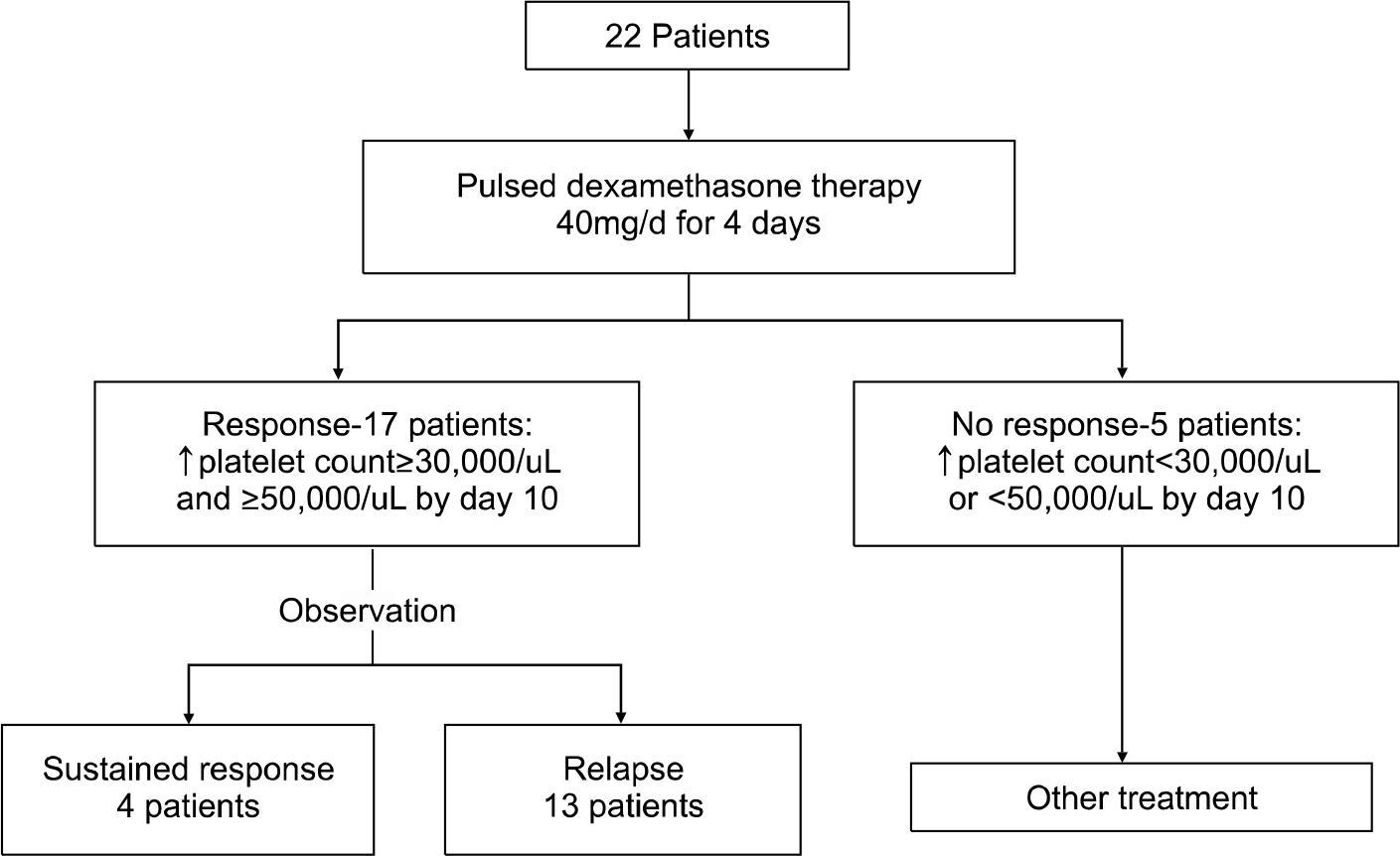Abstract
Background
Corticosteroids have been widely used for treatingidiopathic thrombocytopenic purpura (ITP) as a first-line treatment. Several different pulsed high-dose dexamethasone therapies for adult ITP have been reported on. We assessed the effectiveness of a single course of high dose dexamethasone as first-line treatment for adult patients with ITP.
Methods
The subjects of the study were previously untreated adult patients with newly diagnosed ITP and who had a platelet count of less than 20,000/μL or a platelet count less than 50,000/μL. High-dose dexamethasone at a dose of 40mg/day for four consecutive days was given orally. A response was defined as an increase in the platelet count of at least 30,000/μL and a platelet count of more than 50,000/μL by day 10 after the initial treatment. A sustained response was defined as a platelet count of more than 50,000/μL that was maintained for six months after the initial treatment.
Results
Twenty two patients were eligible. The median platelet count before treatment was 19,000/μL. Seventeen patients (77%) among the 22 patients achieved an initial response by day 10: the mean platelet count 10 days after the initial treatment was 144,000/μL (range: 51,000 to 428,000/μL). Among the patients with a response, 4 (23.5%) had a sustained response, and the other 13 (76.5%) relapsed within six months. All the patients well tolerated the high-dose dexamethasone treatment.
Go to : 
References
1. McMillan R. Antigen-specific assays in immune thrombocytopenia. Transfus Med Rev. 1990; 4:136–43.

2. van Leeuwen EF, van der Ven JT, Engelfriet CP, von dem Borne AE. Specificity of autoantibodies in autoimmune thrombocytopenia. Blood. 1982; 59:23–6.

3. McVerry BA. Management of idiopathic thrombocytopenic purpura in adults. Br J Haematol. 1985; 59:203–8.

4. Geroge JN, Woolf SH, Raskob GE, et al. Idiopathic thrombocytopenic purpura: a practice guideline developed by explicit methods for the American Society of Hematology. Blood. 1996; 88:3–40.
5. George JN, el-Harake MA, Raskob GE. Chronic idiopathic thrombocytopenic purpura. N Engl J Med. 1994; 331:1207–11.

6. McMillan R. Therapy for adults with refractory chronic immune thrombocytopenic purpura. Ann Intern Med. 1997; 126:307–14.

7. Bellucci S, Charpak Y, Chastang C, Tobelem G. Low doses v conventional doses of corticoids in immune thrombocytopenic purpura (ITP): results of a randomized clinical trial in 160 children, 223 adults. Blood. 1988; 71:1165–9.

9. Mazzucconi MG, Francesconi M, Fidani P, et al. Treatment of idiopathic thrombocytopenic purpura (ITP): results of a multicentric protocol. Haematologica. 1985; 70:329–36.
10. Apostolidis J, Tsandekidi M, Kousiafes D, et al. Short-course corticosteroid-induced pulmonary and apparent cerebral aspergillosis in a patient with idiopathic thrombocytopenic purpura. Blood. 2001; 98:2875–7.

11. Portielje JE, Westendorp RG, Kluin-Nelemans HC, Brand A. Morbidity and mortality in adults with idiopathic thrombocytopenic purpura. Blood. 2001; 97:2549–54.

12. Andersen JC. Response of resistant idiopathic thrombocytopenic purpura to pulsed high-dose dexamethasone therapy. N Engl J Med. 1994; 330:1560–4.

14. Warner M, Wasi P, Couban S, Hayward C, Warkentin T, Kelton JG. Failure of pulse high-dose dexamethasone in chronic idiopathic immune thrombocytopenia. Am J Hematol. 1997; 54:267–70.

15. Cheng Y, Wong RS, Soo YO, et al. Initial treatment of immune thrombocytopenic purpura with high-dose dexamethasone. N Engl J Med. 2003; 349:831–6.

16. Pamuk GE, Pamuk ON, Baslar Z, et al. Overview of 321 patients with idiopathic thrombocytopenic purpura. Retrospective analysis of the clinical features and response to therapy. Ann Hematol. 2002; 81:436–40.
17. George JN. Initial management of adults with idiopathic (immune) thrombocytopenic purpura. Blood Rev. 2002; 16:37–8.

18. Wali YA, Al Lamki Z, Shah W, Zacharia M, Hassan A. Pulsed high-dose dexamethasone therapy in children with chronic idiopathic thrombocytopenic purpura. Pediatr Hematol Oncol. 2002; 19:329–35.

19. Schiavotto C, Ruggeri M, Castaman G, Rodeghiero F. High-dose dexamethasone in adult refractory idiopathic thrombocytopenic purpura. Br J Haematol. 1996; 93:491–2.
20. Demiroğlu H, Dündar S. High-dose pulsed dexamethasone for immune thrombocytopenia. N Engl J Med. 1997; 337:425–7.

22. Caulier MT, Rose C, Roussel MT, Huart C, Bauters F, Fenaux P. Pulsed high-dose dexamethasone in refractory chronic idiopathic thrombocytopenic purpura: a report on 10 cases. Br J Haematol. 1995; 91:477–9.

23. Mazzucconi MG, Fazi P, Bernasconi S, et al. Therapy with high-dose dexamethasone (HD- DXM) in previously untreated patients affected by idiopathic thrombocytopenic purpura: a GIMEMA experience. Blood. 2007; 109:1401–8.
Go to : 
 | Fig. 1.Treatment protocol and results in 22 patients with newly diagnosed idiopathic thrombocytopenic purpura. |
Table 1.
Comparison of clinical and laboratory variables between responder and unresponder∗†
| Variable | Responder (17 patients) | Unresponder (5 patient) | P-value |
|---|---|---|---|
| Age (yr) | 36.59±16.2 | 59.20±22.1 | 0.065 |
| Sex (no.) | 0.781 | ||
| Male | 8 | 2 | |
| Female | 9 | 3 | |
| Platelet count (per μL)† | |||
| Pretreatment | 20,000 | 14,000 | 0.969 |
| Day 2 | 45,000 | 28,000 | 0.327 |
| Day 3 | 77,000 | 39,000 | 0.005 |
| Day 4 | 109,000 | 41,000 | 0.003 |
| Day 10 | 144,000 | 11,000 | 0.001 |
Table 2.
Comparison of clinical and laboratory variables between sustained response and relapse among the 17 patients with an initial response∗
| Variable | Sustained response (4 patients) | Relapse (13 patient) | P value |
|---|---|---|---|
| Age (yr) | 44.50±22.87 | 34.15±13.90 | 0.893 |
| Sex (no.) | 0.394 | ||
| Male | 2 | 6 | |
| Female | 2 | 2 | |
| Platelet count (per μL)† | |||
| Pretreatment | 26,500 | 18,000 | 0.720 |
| Day 2 | 54,000 | 28,000 | 0.125 |
| Day 3 | 113,500 | 63,000 | 0.079 |
| Day 4 | 149,000 | 109,000 | 0.245 |
| Day 10 | 191,000 | 115,000 | 0.236 |
| Day 30 | 207,000 | 120,500 | 0.034 |




 PDF
PDF ePub
ePub Citation
Citation Print
Print


 XML Download
XML Download